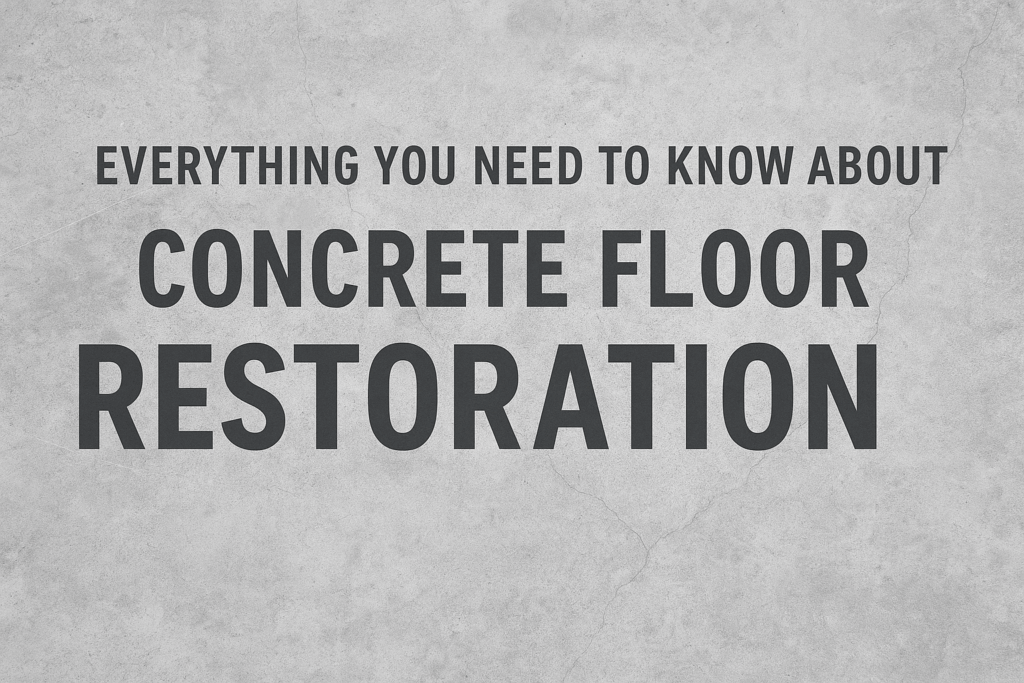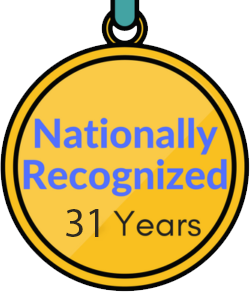
Concrete floors are tough. They carry the weight of forklifts in warehouses, survive heavy foot traffic in retail spaces, and endure spills, scratches, and daily wear in homes. But tough doesn’t mean indestructible. Over time, even the strongest concrete starts showing its age: cracks spider across the surface, dull patches replace that once-polished sheen, and stains seem impossible to scrub out.
That’s where concrete floor restoration steps in—a process that can take a tired slab and make it look new again while improving safety and extending its life. Whether you’re a homeowner with a cracked garage floor, a property manager in charge of hundreds of square feet of commercial flooring, or a contractor weighing the best options for your client, this guide lays everything out for you.
Why Concrete Floors Lose Their Charm Over Time
Concrete is tough, but it’s constantly under pressure—literally and figuratively. In warehouses, garages, retail stores, and industrial facilities, these floors carry the weight of heavy equipment, vehicle traffic, rolling carts, and constant footfall. Over time, that stress adds up.
Moisture is another culprit. Concrete is porous by nature, and water seeps in—whether from spills, humidity, or cleaning. This leads to expansion and contraction within the slab, which causes small cracks, surface flaking, or even spalling in extreme cases. Harsh cleaning agents or chemical spills can etch into the surface, especially if it’s unsealed or the finish has worn down.
Dust and grit, combined with daily foot traffic, act like sandpaper—dulling finishes and wearing down protective coatings. Scratches build up. Stains set in. High-gloss finishes turn cloudy. What was once sleek and smooth starts to look blotchy and uneven.
In commercial settings, these problems aren’t just cosmetic. Damaged or uneven concrete can pose slip, trip, and fall hazards. It may even lead to downtime if repairs are needed during operating hours.
While tearing out the slab and starting over is one solution, it’s rarely the best one. Restoration makes more sense—it preserves the original surface and restores both function and appearance without the cost or disruption of replacement.
What Exactly Is Concrete Floor Restoration?
Concrete floor restoration is the process of repairing, refinishing, and improving existing concrete surfaces to extend their lifespan and restore their appearance and performance. Rather than removing and replacing the entire slab, restoration focuses on correcting surface-level damage, addressing structural issues, and applying new finishes that enhance both function and aesthetics.
This process is often more efficient and cost-effective than full replacement. It minimizes downtime, avoids demolition waste, and makes use of the existing foundation. Restoration can be tailored to the specific problems of each floor, whether they stem from wear and tear, moisture intrusion, chemical exposure, or uneven settling.
Depending on the condition of the surface, restoration might include several steps such as:
- Concrete resurfacing: Applying a cement-based overlay to renew worn or stained surfaces and provide a clean, uniform appearance.
- Concrete leveling: Lifting and stabilizing sunken or uneven sections using techniques like self-leveling compounds or polyurethane foam injection.
- Crack repair: Sealing small or large fractures to prevent them from widening and compromising the integrity of the floor.
- Polishing and sealing: Mechanically grinding and smoothing the surface followed by applying sealers that protect against stains, moisture, and abrasion.
Well-executed restoration not only improves safety and durability but can also make the floor easier to maintain and more visually appealing.
Concrete Resurfacing: A Practical and Aesthetic Upgrade
When the surface of a concrete floor is worn, chipped, stained, or just looks tired, resurfacing offers a way to renew it without replacing the entire slab. The process involves applying a polymer-modified cement overlay that adheres to the existing concrete. This creates a smooth, durable top layer that covers imperfections and extends the floor’s life.
Resurfacing is commonly used in garages, warehouses, showrooms, retail environments, and even residential interiors. It can be tailored to suit both functional and decorative needs. In industrial settings, the priority is usually durability and slip resistance. In commercial or residential spaces, the overlay can be stamped, textured, or colored to resemble tile, natural stone, or wood.
Beyond aesthetics, resurfacing improves performance. It can mask surface-level damage, provide a uniform finish, and even correct minor pitting or scaling. It’s a cost-effective solution that avoids the disruption, debris, and labor costs associated with full slab replacement.
Concrete Leveling: Fixing Uneven and Sunken Floors
Uneven concrete isn’t just inconvenient. It can cause serious problems in both commercial and residential spaces. Low spots collect water, high spots become tripping points, and sloped or settled slabs can damage equipment and shelving.
Concrete leveling restores balance to a floor by lifting sunken areas and eliminating irregularities. There are several methods, depending on the scope and location of the issue:
- Self-leveling compounds: Used for indoor floors with mild variations. These fast-setting mixtures are poured and spread to create a flat, smooth surface.
- Mudjacking: Involves pumping a cement-based slurry beneath the slab through small holes to raise it to the correct height. This is more common in exterior applications or heavy-use spaces.
- Polyurethane foam injection: A modern alternative that uses expanding foam to lift and stabilize the slab. It’s faster, lighter, and causes less disruption than traditional methods.
Leveling not only makes the surface safer and more visually consistent but also prevents long-term structural damage and costly repairs down the line.
Concrete Crack Repair: Containing Damage Before It Grows
Cracks are more than cosmetic flaws. They signal stress within the concrete and, if ignored, can allow water, chemicals, and debris to penetrate deeper into the slab. This accelerates deterioration and, in some climates, leads to freeze-thaw damage that widens the cracks over time.
Effective crack repair starts with cleaning out loose material and assessing the depth and cause of the damage. Once prepped, the crack is filled with a high-strength repair material, typically epoxy or polyurethane. These materials bond tightly to the surrounding concrete and flex slightly with movement, making them suitable for both structural and non-structural repairs.
A proper seal over the repaired area prevents moisture intrusion and helps stop the crack from spreading. In high-traffic or sensitive areas, crack repairs can be followed by resurfacing or sealing for added protection.
Early intervention keeps damage localized and extends the life of the floor, avoiding more extensive repairs later.
Polishing and Sealing: The Finishing Touch
One of the most transformative parts of concrete floor restoration is polishing and sealing. This process grinds the surface to a smooth, even finish, then seals it to lock out stains and moisture.
The result? Floors that look glossy, resist spills, and are much easier to clean. In fact, polished concrete is becoming a go-to flooring choice in showrooms, offices, and even residential kitchens because it looks sleek and modern without the upkeep of tile or hardwood.
For businesses especially, regular concrete floor cleaning and concrete scrubbing & cleaning keep polished surfaces in top shape, extending the life of the restoration.
How Much Does Concrete Floor Restoration Cost?
Cost is usually the first concern when considering concrete restoration. While there’s no single answer, pricing is shaped by several key factors:
- Size of the area: Larger spaces often have a lower cost per square foot, but the overall expense is still higher. A small residential floor may cost less than a large industrial space even if the square footage rate is slightly higher.
- Extent of damage: Light surface wear may only need polishing, while heavily damaged floors could require resurfacing, leveling, and repairs.
- Type of finish: Standard finishes are more affordable, but high-gloss polishing or decorative overlays raise the price.
- Geographic location: Labor rates and material availability vary by region, which impacts pricing.
Typical price ranges include:
- Concrete resurfacing: $3 to $10 per square foot
- Concrete polishing: $3 to $8 per square foot
- Crack repair: $2 to $4 per linear foot
- Foam injection leveling: $5 to $25 per square foot
For example, refinishing a 1,000 square foot floor might cost anywhere from $3,000 to $10,000 depending on the condition of the slab, chosen finish, and local rates.
Is It Worth Resurfacing Concrete?
In most cases, resurfacing is well worth the investment. For property owners dealing with worn, stained, or cracked concrete, restoration offers several advantages over a full replacement:
- Lower cost: Restoring an existing slab is far less expensive than tearing it out and pouring new concrete. It also reduces labor time and disposal costs.
- Longer lifespan: A properly restored concrete floor can last 10 to 20 more years with the right maintenance.
- Improved safety and presentation: Restoration creates smoother, safer walking surfaces and enhances the look of the space.
For commercial properties, well-maintained floors can create a more professional environment and reduce ongoing maintenance costs. In residential spaces, resurfaced concrete in basements, garages, or patios improves usability and appeal.
How to Restore an Old Concrete Floor: Step by Step
Restoring a concrete floor involves more than applying a quick patch or sealer. A proper restoration project follows a series of deliberate steps designed to ensure durability and performance:
- Inspection: A contractor assesses the floor’s condition, looking for cracks, moisture issues, surface wear, and structural settling.
- Surface preparation: This includes cleaning, degreasing, and possibly grinding the surface to remove old coatings or rough spots.
- Repairs: Any damage such as cracks, pits, or uneven sections are repaired to create a stable base.
- Resurfacing or polishing: Depending on the project’s goals, the contractor may apply an overlay for a new surface or polish the existing one to a high sheen.
- Sealing: A protective layer is applied to guard against stains, moisture, and abrasions.
- Final cleaning and care instructions: After the restoration, a contractor may offer maintenance advice or service plans to keep the floor in good condition.
Each of these steps ensures the restored floor performs well over time and meets the needs of the space.
Maintenance Matters: Keeping Restored Concrete in Shape
Restored concrete floors are built to last, but only with proper upkeep. Without regular maintenance, even a well-restored surface can start to show wear. To protect your investment:
- Schedule periodic concrete cleaning: Routine scrubbing helps prevent grime and grit from damaging the finish.
- Reapply sealers as needed: Depending on the level of foot traffic and type of use, sealers may need to be refreshed every few years.
- Clean spills quickly: Oil, chemicals, and colored liquids can stain concrete if not addressed promptly.
- Avoid corrosive chemicals: Harsh cleaning products may strip protective coatings and reduce durability.
Maintenance is straightforward but makes a major difference in long-term performance and appearance.
Concrete Floor Restoration in Different Settings
The needs of a concrete floor can vary widely based on how and where it’s used. Restoration strategies are tailored to each environment:
- Residential garages and basements: Common concerns include cracks, moisture infiltration, and stains. Restoration here often focuses on repair, sealing, and moisture control.
- Warehouses and distribution centers: Floors must be level and polished to support equipment like forklifts and pallet jacks. Smoother surfaces reduce wear on machinery and improve safety.
- Retail stores and showrooms: Aesthetics matter. Decorative overlays and polished finishes help create an appealing space for customers.
- Restaurants and kitchens: Non-slip coatings and stain-resistant sealers are important for health and safety compliance.
Each setting requires a different combination of repair, finish, and protection based on usage demands.
DIY vs. Professional Concrete Floor Restoration
Some small restoration tasks—like sealing or crack repair—can be handled using DIY kits. These are best suited for minor damage in residential settings. However, when it comes to larger areas, structural issues, or decorative finishes, professional services are the better option.
Professionals bring specialized equipment such as planetary grinders, industrial vacuums, and high-quality sealers. They understand how to prep the surface properly, apply materials evenly, and ensure the finished floor performs well. Mistakes made during a DIY project—like uneven overlays or improper sealing—can lead to poor results and even shorten the life of the floor.
For most medium to large projects, or when durability and appearance matter, professional restoration is the safer, more reliable choice.
Choosing the Right Partner for the Job
Hiring the right contractor is key to a successful restoration. The ideal partner doesn’t just repair the surface; they understand how different environments and floor types affect restoration choices.
When interviewing contractors, ask the following:
- Do they specialize in residential, commercial, or both?
- What specific restoration methods do they recommend for your floor’s condition and use case?
- Can they share before-and-after examples of similar projects?
- Do they offer maintenance or cleaning services after the work is complete?
Experience, communication, and transparency are just as important as skill. A reliable contractor will walk you through the process, explain your options, and help you make informed decisions that protect your floor for years to come.
About TCS Floors

At TCS Floors, restoring concrete isn’t just about fixing cracks or polishing surfaces—it’s about giving your floors a second life. With years of experience serving homeowners, businesses, and property managers, TCS Floors combines technical expertise with a commitment to quality service.
Their team handles everything from concrete floor cleaning to advanced concrete scrub/seal services, ensuring every project not only looks good on day one but stays durable for years.
If you’re in California and searching for “concrete floor restoration near Los Angeles, CA” or “concrete floor restoration near San Diego, CA,” TCS Floors is a trusted local choice.
Conclusion
Concrete floor restoration is more than a quick fix—it’s a smart investment in the life, safety, and beauty of your property. Whether it’s resurfacing, leveling, crack repair, or polishing, the right approach can breathe new life into old, worn-out floors.
And if you’re wondering whether it’s worth it? Just picture the difference between a cracked, stained floor and a smooth, polished surface that reflects light and resists wear. That’s the value restoration delivers.
FAQs
Restoring an old concrete floor usually starts with a thorough cleaning to remove dirt, grease, and coatings. Next, cracks and holes are repaired to stabilize the surface. Depending on the floor’s condition, it may be resurfaced with a thin overlay, leveled, or polished and sealed to bring back a smooth finish. For severely worn areas, grinding the top layer before applying a protective sealer ensures a durable result.
The cost to resurface a concrete floor typically ranges from $3 to $10 per square foot. The price depends on the size of the area, the extent of damage, and whether you choose a basic overlay or a decorative finish. Commercial spaces and custom designs usually fall on the higher end of that range, while simple garage or basement resurfacing is more affordable.
Refinishing a 1,000 sq. ft. indoor concrete floor usually costs between $3,000 and $10,000. The exact price depends on the chosen method—basic polishing will cost less than decorative overlays or heavy crack repair. Location and labor rates can also influence the final number.
Yes, resurfacing concrete is almost always worth it. It’s far more affordable than replacement, extends the life of your existing floor by 10–20 years, and instantly improves appearance and safety. For businesses, it can lower maintenance costs and create a better impression on customers. For homeowners, it boosts property value and makes spaces like garages and basements more functional.


